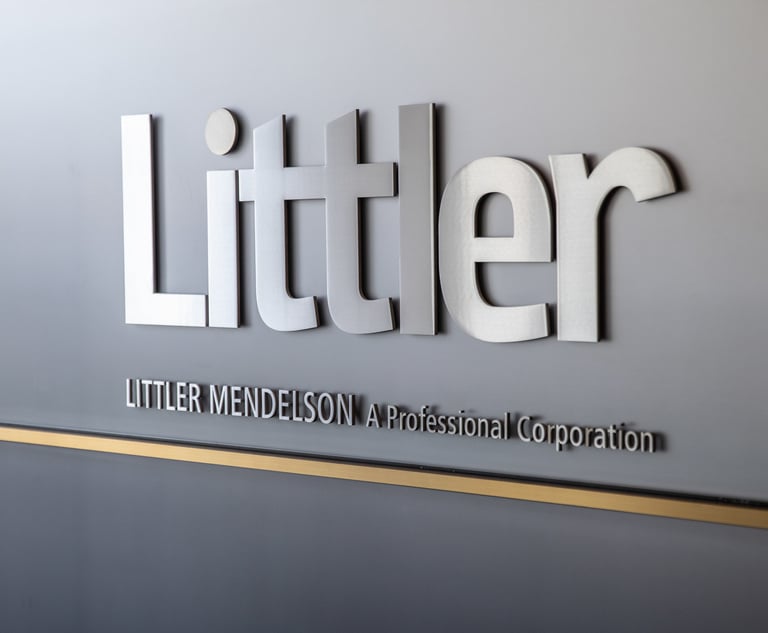Law Firm Revenue Rose as Demand Dropped in the First Quarter of 2019
The legal industry saw greater revenue growth during the first quarter of 2019 than it did to start the strong year of 2018. However, the drivers of…
May 13, 2019 at 05:30 AM
7 minute read

The legal industry saw greater revenue growth during the first quarter of 2019 than it did to start the strong year of 2018. However, the drivers of that growth were much different, as the demand growth that characterized 2018 gave way to a demand decline during the first quarter of 2019, and much of the revenue growth came in the form of cash collections from 2018 inventory. Billing rate increases continued at the elevated pace that we saw in 2018, and they retake their position as the primary revenue driver to begin 2019, as they have been for much of the post-recession period. Looking ahead, the industry maintains a strong inventory position heading into the second quarter, which should continue to provide momentum. This is important, as expense pressure, which had also been a theme of 2018, outpaced revenue growth and is likely to accelerate into the second quarter.
These results are based on a sample of 187 firms (75 Am Law 100 firms, 52 Second Hundred firms and 60 niche/boutique firms). Thirty-two of these firms fit our definition of either “international” (less than 25% but more than 10% of lawyers based outside the United States) or “global” (at least 25% of lawyers based outside the United States). Citi Private Bank provides financial services to more than 600 U.S. and U.K. law firms and more than 35,000 individual lawyers. Each quarter, the Law Firm Group confidentially surveys firms in the Am Law 100 and the Second Hundred, along with smaller firms. In addition, we conduct a more detailed annual survey and semiannually produce the Law Firm Leaders Confidence Index. These reports, together with extensive discussions with law firm leaders, provide a comprehensive overview of current financial trends in the industry as well as forward-looking insight.
Revenue growth of 4.5% in the first quarter of 2019 was driven largely by lawyer billing rate growth of 4.4%, as demand declined 0.3%. Firms told us that the government shutdown in January, volatility in the markets, and a comparatively weaker M&A market contributed to the demand decline. The collection cycle lengthened 1% on average, and firms continue to tell us that a shift in client bill payment behavior drove much of this collections slowdown. That said, inventory growth levels moderated from year-end 2018, and many firms did drive revenue growth through cash collection from 2018 inventory. Still inventory growth remained relatively strong at 5.6% and should continue to provide collections momentum into the second quarter.
Expense growth of 6.5% significantly exceeded revenue growth and compressed the profit margin during the first quarter. Lawyer compensation expense growth of 7.2% continued to drive much of expense growth. Some of that increase was driven by lawyer headcount growth of 1.8%. Perhaps the greater pressure comes from the mid-2018 associate compensation increases, which will continue to place upward pressure on expenses until those increases are mostly priced in after the first half of this year. That said, operating expenses are also up materially at 5.9%, the largest first quarter operating expense increase since 2012.
Though firms continued to add lawyers, they did not materially grow the equity partnership (0.2%), driving lawyer leverage higher (2.1). Meanwhile, with increased leverage and its associate cost, lawyer productivity declined 1.8%, reversing the gains the industry saw in 2018.
Behind these averages, we continue to see high levels of dispersion in demand performance as 53% of firms saw demand decline during the first quarter of 2019. We also saw volatility in demand performance, defined as alternating periods of demand growth and decline. To measure volatility in demand performance, we looked at the 149 firms that reported first-quarter results in 2017, 2018 and 2019. Approximately 47% of these firms either saw demand increase in the first quarter of 2018 and decrease in the first quarter of 2019, or vice versa. Further, 26% of firms saw demand decline in both periods.
Looking at the results by revenue size, Am Law 51-100 firms had the best start to the year. These firms saw the greatest revenue growth at 8.1% and were the only segment to see revenue growth exceed expense growth. They also saw the greatest demand growth at 1.2% and saw lawyer billing rate increases of 4.1%. They had by far the greatest shortening of the collection cycle at 3%, and this materially aided their revenue growth. Even so, they also carry a 4.9% inventory increase into the second quarter, the second-largest among the segments.
Contrary to recent results, the Am Law 1-50 firms underperformed the industry in a number of ways. In particular, these firms saw a demand decline of 0.7%, a departure from recent trends. However, Am Law 1-50 firms continued to see the greatest lawyer billing rate increases at 5% and this drove revenue higher by 4.3%, second only to the Am Law 51-100 firms. Am Law 1-50 firms also saw the collection cycle lengthen by 2.2% and carry the largest inventory increase (6.6%) into the rest of the year.
The smaller firms in our sample (Am Law Second Hundred firms and other firms) had the most challenged starts of the year. Both segments were well below the industry averages in terms of revenue growth (2.6% and 1.5%, respectively) and lawyer billing rate growth (3% and 1.8%, respectively). Second Hundred firms saw demand stay relatively unchanged while other firms saw a material decline of 2.4%. Both segments also carry less than 3% of inventory growth into the rest of the year.
Looking at firms by geographic reach, global firms saw the greatest demand growth (1.1%) but trailed all other segments in revenue growth (1.1%), despite a billing rate increase that was just slightly below the industry average at 4.1%. This is due to a significant slowing of collections (7.2%). They carry an 8.3% inventory increase into the second quarter, which can help revenue growth recover during the rest of the year.
National and international firms saw the greatest revenue growth (7.4% and 6.3%, respectively), however neither saw material demand growth (0.1% growth and 1.1% decline, respectively). International firms drove much of revenue growth through billing rate increases of 5.5%, and national firms turned to collections to drive a large portion of revenue growth as their collection cycle shortened by 3.5%.
Regional firms saw the most challenged start to the year. They reported the largest demand decline at 1.6% and the lowest billing rate increase of 3.8%. Revenue growth of 2% trailed all segments but global firms, yet unlike global firms, regional firms did not report a particularly strong inventory position, up just 4%. All segments but national firms saw expense growth outpace revenue growth during the first quarter, and lawyer compensation expense increases were the primary driver of expense growth for all.
From a revenue growth perspective, 2019 seems to have started similarly to 2018. Helping to drive this result were strong billing rate increases and inventory accumulation that will continue to provide top-line momentum into the second quarter of the year. However, many of the other markers that made 2018 such a strong year for the industry are not present in the 2019 results. The demand growth that made for a balanced revenue growth story in 2018 turned to a demand decline during the first quarter. Expense growth from both lawyer compensation and operating expenses is placing significant pressure on profit margins, and wide market dispersion, which had dissipated somewhat in 2018, has returned in 2019. It will be difficult to build on the success of 2018, and many firms will fall short of that goal. We expect this to drive continued, and potentially increased, dispersion and consolidation in the market.
David Altuna is a client adviser within Citi Private Bank's Law Firm Group and Gretta Rusanow is head of advisory services. Senior client adviser John Wilmouth contributed to this article.
This content has been archived. It is available through our partners, LexisNexis® and Bloomberg Law.
To view this content, please continue to their sites.
Not a Lexis Subscriber?
Subscribe Now
Not a Bloomberg Law Subscriber?
Subscribe Now
NOT FOR REPRINT
© 2025 ALM Global, LLC, All Rights Reserved. Request academic re-use from www.copyright.com. All other uses, submit a request to [email protected]. For more information visit Asset & Logo Licensing.
You Might Like
View All

Three Akin Sports Lawyers Jump to Employment Firm Littler Mendelson

Brownstein Adds Former Interior Secretary, Offering 'Strategic Counsel' During New Trump Term
2 minute read
Trending Stories
- 1People in the News—Jan. 22, 2025—Knox McLaughlin, Saxton & Stump
- 2How I Made Office Managing Partner: 'Be Open to Opportunities, Ready to Seize Them When They Arise,' Says Lara Shortz of Michelman & Robinson
- 3The Intersection of Labor Law and Politics Following the Presidential Election
- 4Critical Mass With Law.com’s Amanda Bronstad: LA Judge Orders Edison to Preserve Wildfire Evidence, Is Kline & Specter Fight With Thomas Bosworth Finally Over?
- 5What Businesses Need to Know About Anticipated FTC Leadership Changes
Who Got The Work
J. Brugh Lower of Gibbons has entered an appearance for industrial equipment supplier Devco Corporation in a pending trademark infringement lawsuit. The suit, accusing the defendant of selling knock-off Graco products, was filed Dec. 18 in New Jersey District Court by Rivkin Radler on behalf of Graco Inc. and Graco Minnesota. The case, assigned to U.S. District Judge Zahid N. Quraishi, is 3:24-cv-11294, Graco Inc. et al v. Devco Corporation.
Who Got The Work
Rebecca Maller-Stein and Kent A. Yalowitz of Arnold & Porter Kaye Scholer have entered their appearances for Hanaco Venture Capital and its executives, Lior Prosor and David Frankel, in a pending securities lawsuit. The action, filed on Dec. 24 in New York Southern District Court by Zell, Aron & Co. on behalf of Goldeneye Advisors, accuses the defendants of negligently and fraudulently managing the plaintiff's $1 million investment. The case, assigned to U.S. District Judge Vernon S. Broderick, is 1:24-cv-09918, Goldeneye Advisors, LLC v. Hanaco Venture Capital, Ltd. et al.
Who Got The Work
Attorneys from A&O Shearman has stepped in as defense counsel for Toronto-Dominion Bank and other defendants in a pending securities class action. The suit, filed Dec. 11 in New York Southern District Court by Bleichmar Fonti & Auld, accuses the defendants of concealing the bank's 'pervasive' deficiencies in regards to its compliance with the Bank Secrecy Act and the quality of its anti-money laundering controls. The case, assigned to U.S. District Judge Arun Subramanian, is 1:24-cv-09445, Gonzalez v. The Toronto-Dominion Bank et al.
Who Got The Work
Crown Castle International, a Pennsylvania company providing shared communications infrastructure, has turned to Luke D. Wolf of Gordon Rees Scully Mansukhani to fend off a pending breach-of-contract lawsuit. The court action, filed Nov. 25 in Michigan Eastern District Court by Hooper Hathaway PC on behalf of The Town Residences LLC, accuses Crown Castle of failing to transfer approximately $30,000 in utility payments from T-Mobile in breach of a roof-top lease and assignment agreement. The case, assigned to U.S. District Judge Susan K. Declercq, is 2:24-cv-13131, The Town Residences LLC v. T-Mobile US, Inc. et al.
Who Got The Work
Wilfred P. Coronato and Daniel M. Schwartz of McCarter & English have stepped in as defense counsel to Electrolux Home Products Inc. in a pending product liability lawsuit. The court action, filed Nov. 26 in New York Eastern District Court by Poulos Lopiccolo PC and Nagel Rice LLP on behalf of David Stern, alleges that the defendant's refrigerators’ drawers and shelving repeatedly break and fall apart within months after purchase. The case, assigned to U.S. District Judge Joan M. Azrack, is 2:24-cv-08204, Stern v. Electrolux Home Products, Inc.
Featured Firms
Law Offices of Gary Martin Hays & Associates, P.C.
(470) 294-1674
Law Offices of Mark E. Salomone
(857) 444-6468
Smith & Hassler
(713) 739-1250









